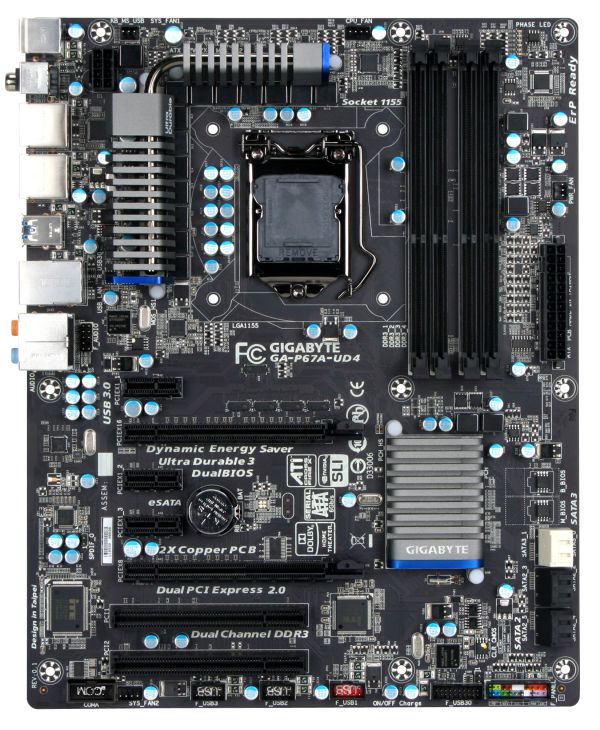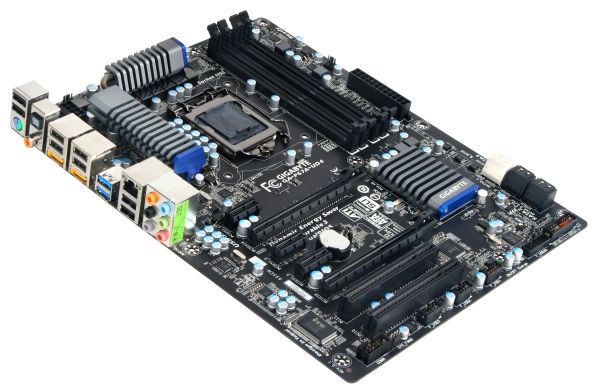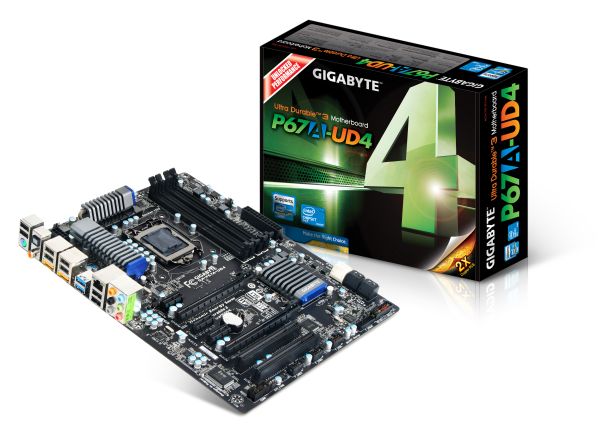The Battle of the P67 Boards - ASUS vs. Gigabyte at $190
by Ian Cutress on January 20, 2011 4:15 PM EST- Posted in
- Motherboards
- Gigabyte
- Asus
- P67
Gigabyte has five P67 motherboards up for the US Sandy Bridge release – the P67A-UD3, the P67A-UD3P, the P67A-UD4, the P67A-UD5 and the P67A-UD7. At least the naming scheme is as easy to follow as previous generations – the higher the last number, the more expensive the board and the more features on offer:
| P67A Series | |||||
| P67A-UD3 | P67A-UD3P | P67A-UD4 | P67A-UD5 | P67A-UD7 | |
| Price | $130 | $160 | $190 | $260 | $320 |
|
SATA 6 Gb/s SATA 3 Gb/s eSATA |
2 4 0 |
2 4 0 |
2 4 2 |
2 4 2 |
4 4 2 |
|
CrossFireX SLI |
Yes No |
Yes No |
Yes Yes |
Yes Yes |
Yes Yes |
|
USB 3.0 USB 2.0 |
2 12 |
4 14 |
4 14 |
8 10 |
10 8 |
| LAN | 1 | 1 | 1 | 1 | 2 |
| PCIe |
2 x16 (1 x16, 1 x4) |
2 x16 (1 x16, 1 x4) |
2 x16 (2 x8) |
3 x16 (2 x8, 1 x4) |
4 x16 (2 x16 or 4 x8) |
Visual Inspection
One of the first things I noticed about the P67A-UD4 was that it was not blue and white, like the majority of the Gigabyte motherboards have been recently that I have worked with. Predominantly featuring a black PCB, black PCIe connectors, black DIMM slots, black SATA 3Gb/s ports, a splash of white for SATA 6GB/s, silver chipset/FET coolers and a hint of old Gigabyte blue on those coolers is what we get this iteration. Not the whole range is like this – I have a H67 Gigabyte board on my desk here and that retains the blue and white credentials, as does the P67A-UD3.
The PCIe layout is slightly different to other P67 boards I have reviewed – with only two PCIe x16 slots (going to x8/x8 in dual GPU mode), there is an extra PCIe x1 slot on the board. In a dual GPU setup, this leaves two PCIe x1 and a PCI slot still free on the board, as well as a gap between dual slot GPUs to aid in cooling.
Fan headers on the board are located near the 8-pin power connector, one above the socket, one above the 24-pin power connector, and one below the PCIe slots, which would only be covered if you have a dual slot PCI card.
Gigabyte’s dual BIOS system is on this board. Yes, that is right – BIOS. No UEFI here. Well, that's not strictly true, as one of the latest BIOS updates at the time of writing (F6) implements an EFI into the BIOS, reportedly allowing bootable access to hard drives over 2.2TB. This is due to, as Gigabyte explained, that their board is actually UEFI, but without a proper GUI interface like other boards. They've used the old BIOS-style interface for now, as after years of plugging away they believe it's quick, stable and recognisable for consumers to understand. So underneath, it's truly 64-bit, meaning 2.2TB+ partition support is possible, and could also suggest that a new GUI is coming in the future. I asked about time-scale for this, but Gigabyte were undoubtedly tight-lipped about dates and implementations.
Visually, in terms of the board, there is not much else to say – the space between the socket and the PCI slots is virtually clear. There are no power, reset or clear CMOS buttons on board, neither is there a debug LED, and which is a real shame given that ASRock can do it on a $150 motherboard. Compared to the ASUS board, all the energy saving and turbo performance options are all software based – no easy flick of switches here.
Like the other P67 boards, the back panel is regular as well. Only a single PS/2 connector, 8 USB 2.0 ports, 2 USB 3.0 ports, 2 eSATA ports, S/PDIF Out connectors, a single gigabit Ethernet, and audio I/O.














137 Comments
View All Comments
Rick83 - Friday, January 21, 2011 - link
An ASUS Xonar DX costs around 50-70$ and does the same, and remains portable to any pcie board. I chose to go with that in the end...sweetspot - Friday, January 21, 2011 - link
See this is the point exactly overlooked,""go get so and so sound card to solve your problems, but now look at the equation posted in the review ""
2x 190 mobos or the 150 mobo which is better save 40 bucks ??
See how can you save 40 bucks when they clearly did not do sound review at all, so you now need to go pay the extra 50-70 bucks for add on sound card, now you are not saving 40 bucks with the Asrock board are ya.
Sure reader can go elsewhere and do alot of extra research on the parts for that info, but the review sites are supposed to cover that whcih is the whole reason people read them in the 1st place to get info they dont have access to read and not have to go web hopping for each detail to get information, and let an expert reviewer cover that research and testing for them, the whole reason review sites exsist. leaving out details so readers have to go elsewhere for items they reviewed is not a very helpfull at all, and readers waste time reading this to find out they are SOL later on, and need to spend more time on other sites for overlooked details.
Sound is not small item or bug oversite, every mobo computer usually sound is a key part of their use for home / entertainment use types. So skipping sound and other mojor compnents in a review is terrible to the reader.
Voldenuit - Friday, January 21, 2011 - link
Blegh. Too expensive.Pass.
Concillian - Friday, January 21, 2011 - link
Agree.Seen a fair number of reviews of various $150+ P67 boards.
OCing the 2500k looks to be about as non-complex as it gets, does a mobo really make a big difference anymore aside from 20 phase VRMs or whatever for the people doing water and phase change cooling and pumping 1.5 volts through these things?
Seems like a normal person on air going for 4.4-4.6 should need nothing fancy except whatever pci-E slot config and ports they are after.
I'm waiting on a <$150 roundup somewhere.
Rick83 - Friday, January 21, 2011 - link
The worst part, is that I got a p55 UD5 for 150 euro, which has more features than the new UD5. (And cost less at launch)I don't even want to talk about the feature-decay with regard to my IP35 Pro.
It's a sad state for the mobo buyer and best to stick to the low end.
Cashano - Friday, January 21, 2011 - link
I read a lot of comments about wait for the (X/Z)(67/68) boards, problem is by then AMD is on the playing field with they new chipset and boards, but lets look at todays boards.When testing boards at $190, i would say its more fitting to test the ASRock P67 Extreme6 instead of the ASRock P67 Extreme4, seeing that its closer to the $190 mark and alot more SATA and V16 power, but thats just what I think.
Cashano.
Cashano - Friday, January 21, 2011 - link
Forgot to add, that Ext6 has 2x 1Gbit LAN, or combined 2Gbit :P new feature.Cashano
seamusmc - Friday, January 21, 2011 - link
Who really uses that feature though. I've never met anyone that takes advantage of that. Would be neat to try it.Hogan773 - Friday, January 21, 2011 - link
No - the POINT is that you compare based on what you GET and the ASRock is delivering all the features (and more) vs the $190 tier at both ASUS and GB.Maybe you're different, but when I buy something, my thought process is not "OK how much to I want to spend" but rather "what features do I want to buy" and from there, where can I get the lowest dollar price on said features.
BTW beyond the bigger power phases there doesn't seem to be that many diffs between the ASR 4 and ASR 6. Thats prob because the ASR 4 is pretty fully loaded.
Cashano - Friday, January 21, 2011 - link
You are right that there isn't a lot of difference between X4 and 6, from what i can see it is,X6 has 2x SATA3(raid), 4x SATA3(raid), 4x SATA2(raid), and V16+2 phase power, and Dual Lan.
X4 has 2x SATA3(raid), 2x SATA3(raid), 4x SATA2(raid), and V8+2 phase power, and Single Lan.
I don't know the price difference is in the US, I think its down to about $10.
Well my thought process is, what do I need here and now for cheapest price, and what do I need in 3 to 6 months, for expansion and upgrades (like crossfire and hard disk's) but that's just me.
But yes I would take the X4 over X6 if i didn't use Dual lan, or used 2 Raid setups.
Cashano